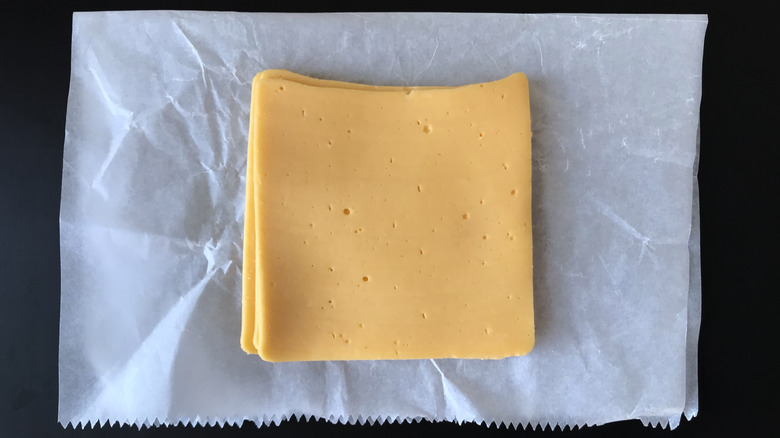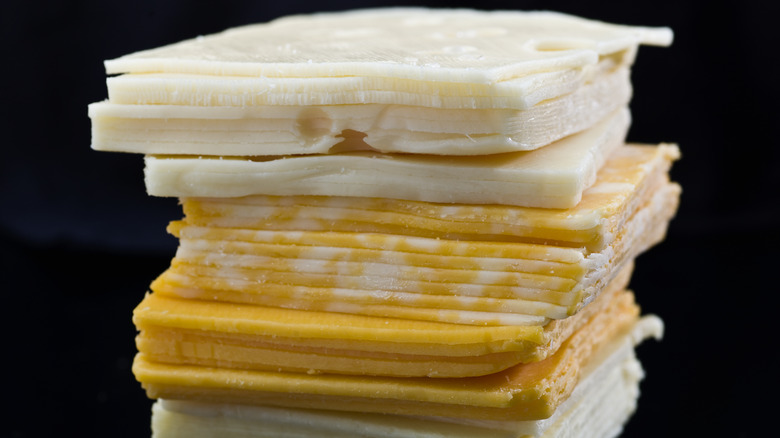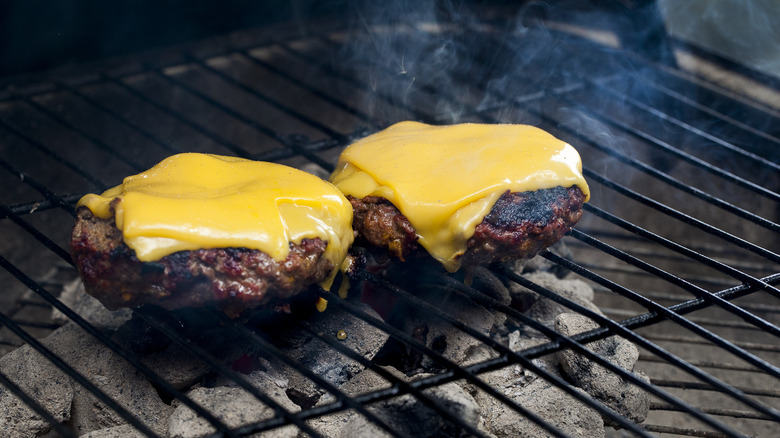Why There's A Suspicious 'Cheese Product' Label On American Cheese
When people think about cheese, the image they summon to mind is usually the easiest type of cheese to find at the grocery store: American cheese. American cheese almost always comes pre-sliced and often in pre-packaged slices (like Kraft Singles), and it's a bright orange-yellow color, similar to the sharper-tasting cheddar cheese. That orange-yellow usually isn't a natural cheese color, though; cheddar cheese is artificially colored with a seed-based food coloring called annatto. What's more, American cheese has a whole lot else inside it. In fact, the packaging for some American cheese calls it a "pasteurized prepared cheese product" instead of just "cheese."
What does that mean? In the United States, that label comes from the U.S. Food and Drug Administration (FDA), which has rules for companies that produce cheese. A company can only call its product "cheese" if it follows those regulations. Certain types of American cheese don't fit the criteria, so they can't legitimately be called cheese. Instead, they're designated a "pasteurized process cheese" or a "pasteurized process cheese product." To be legally sold as cheese, a product must contain at least 51% real cheese — think of the sliced-to-order blocks of American cheese at your local deli. Any product containing less than 51% real cheese is labeled a "cheese product," meaning it has more additives than actual cheese by volume.
This is what goes into American cheese
What we call "American cheese" is often a blend of cheddar, Colby, and Swiss cheese, or at least it starts as a blend of two or more of those cheeses. Those different cheeses are melted together and mixed with lots of preservatives, and something called an emulsifying agent: A fancy name for any substance that helps ingredients blend together when they normally wouldn't. When it comes to American cheese, the emulsifying agent is often sodium citrate, which is the proper name for salt that comes from citrus fruits. Sodium citrate helps water and fats mix together better, which is how American cheese melts so smoothly.
There are also other ingredients in American cheese like milk fat, whey, a preservative called sorbic acid, and the aforementioned natural food coloring, annatto. How much space do all of these extra ingredients take up? That depends on the American cheese (or process cheese product). Kraft Singles, the individually wrapped "American cheese" slices, as well as those made by Velveeta, contain less than 51% real cheese, which is why they're designeted pasteurized process cheese products instead of simply "cheese."
Grilling with the process cheese product, American cheese
Cheese or not, American cheese is perfectly acceptable to use in casual dishes like cheeseburgers, macaroni and cheese, and simple grilled cheese. All of those foods might have "gourmet" versions that swap out American for true cheeses — the French croque monsieur is sort of a fancy grilled cheese with gruyere and ham — but American is often used because it's a good fit for the dish. American cheese melts easily because of those emulsifiers, and it's got a creamy, mild taste. For an ingredient that's soft in both taste and texture and melts in your mouth, American works well.
American cheese, as we know it, was invented by James Kraft in 1903. That is indeed the same Kraft who started Kraft Foods Inc. (which more recently merged with the ketchup giant Heinz to become Kraft Heinz), and Kraft's American cheese recipe became a U.S. staple by the 1930s. There were plenty of cheeses invented in America before then (like Colby, named after the town in Wisconsin where it was created). However, the Kraft version took on the "American cheese" name in the public eye, just not in the FDA's official rules for real cheese.


